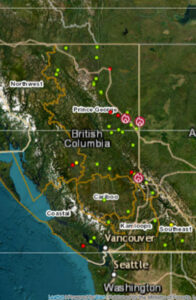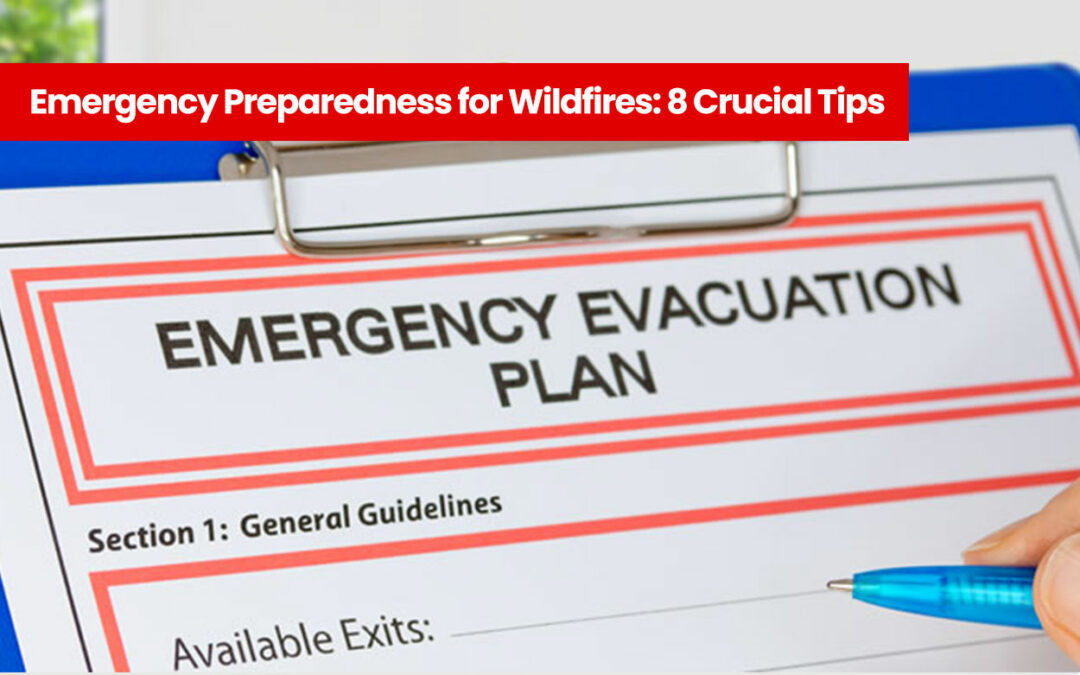Emergency Preparedness for Wildfires: 8 Crucial Tips
Tip #1: Know Your Risk
The first step towards emergency preparedness for wildfires is understanding your risk. In Western Canada, certain areas are more prone to wildfires than others. Check with local authorities, consult maps online, or download fire tracking apps to keep yourself informed about fire-prone areas and current fire incidents. Learn about the BC Emergency Alert System.
Tip #2: Create a Fire-Resistant Zone
Wildfires can spread quickly, and your home’s immediate surroundings can make all the difference. To create a fire-resistant zone, clear your property of dead plants, leaves, and trees. Store firewood and other combustible materials at least 30 feet away from your home. Prune tree limbs that are within 10 feet of the ground to prevent a ground fire from climbing up into the canopy.
Tip #3: Plan and Practice Evacuation Routes
In case of a wildfire, you might need to evacuate quickly. Plan at least two evacuation routes from your home and your community. Regularly practice these routes with your family, including night-time drills. Remember, wildfires can spread rapidly and unpredictably, so your primary route might not always be available.
Tip #4: Prepare an Emergency Kit
An emergency kit is an essential part of emergency preparedness for wildfires. It should include first-aid supplies, bottled water, non-perishable food, a flashlight with extra batteries, a portable charger for your phone, important documents (like birth certificates, passports), prescription medications, cash, and pet supplies if you have animals.
Our Grab-n-Go 4 Person Deluxe 72 Hour Emergency Kit are our BEST SELLER
Check out our 4 Person Search & Rescue Kit
 Tip #5: Stay Informed
Tip #5: Stay Informed
When is comes to emergency preparedness for wildfires, staying informed is a vital part of being prepared. Sign up for local alerts, download wildfire apps, and regularly check the local news for updates on wildfire situations.
Stay informed about the latest threats and emergency preparedness for wildfires alerts HERE.
Tip #6: Understand the Levels of Evacuation
In British Columbia, there are three levels of evacuation: alert, order, and rescind. An evacuation alert means you should prepare to leave. An evacuation order means you need to leave immediately. Finally, an evacuation rescind means it’s safe to return. Familiarize yourself with these levels so you know how to respond when an alert or order is issued.
Tip #7: Create a Family Communication Plan
This emergency preparedness for wildfires plan should include emergency contact numbers, meeting places in case you get separated, and a list of essential items each family member is responsible for during an evacuation. Also, be sure to share your plan with extended family or friends in different locations, so they know your whereabouts and status.
Tip #8: Secure Your Property
If time allows during an evacuation, shut all windows and doors, but leave them unlocked for firefighter access. Remove flammable window shades and curtains, and move furniture away from windows to prevent embers from igniting your home. Taking the right steps and planning your emergency preparedness for wildfires should be your priority especially if you live in a wildfire prone zone.
Emergency Preparedness for Wildfires: SUPPLY LIST
Fire Extinguishers: Have them in your home and vehicle, and ensure everyone knows how to use them.
N95 Respirator Masks: Protect yourself from inhaling harmful particles in degraded air quality during wildfires.
Portable Emergency Weather Radio: Stay informed about weather updates and emergency broadcasts, especially if cell service is disrupted.
Protective Clothing: Prepare a set of clothing for each family member, including long-sleeved shirts, long pants, sturdy shoes, and a dry bandana or cloth.
Map of the Area: In addition to digital maps, keep a physical map of your local area in case digital services are down or you need to plot alternate routes.
Emergency Preparedness for Wildfires: SKILLS
First Aid Training: Knowing how to perform CPR, treat burns, and manage other medical emergencies.
Firefighting Basics: Understanding how to use a fire extinguisher, smother small fires, and when to fight or retreat.
Emergency Communication: Knowing how to reach each other and where to meet if separated during a wildfire event.
Situational Awareness: Learning to read signs of a potential wildfire and being aware of your surroundings.
Basic Survival Skills: Abilities like building a temporary shelter, finding and purifying water, and staying warm.
Mental Resilience: Staying calm, thinking clearly, and maintaining a positive outlook during a traumatic event like a wildfire.


